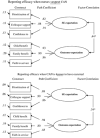Development of the child abuse and neglect reporting self-efficacy questionnaire for nurses
- PMID: 22226061
- PMCID: PMC11916661
- DOI: 10.1016/j.kjms.2011.10.032
Development of the child abuse and neglect reporting self-efficacy questionnaire for nurses
Abstract
Taiwan nurses are mandated to report known or suspected child abuse and neglect (CAN), and self-efficacy is known to have an important influence on professional behaviors. The aim of this study was to develop and test the CAN reporting self-efficacy (CANRSE) scale as a measure of nurses' self-efficacy to report CAN. A sample of 496 nurses from Southern Taiwanese hospitals used the CANRSE scale. The psychometric evaluation of the scale included content validity, exploratory and confirmatory factor analyses, convergent validity, as well as Cronbach's α and test-retest reliability. Satisfactory internal consistency (Cronbach's α = 0.92) and test-retest reliability were demonstrated. Confirmatory factor analysis supported the proposed models as having acceptable model fit. Exploratory factor analysis and regression analyses showed that the CANRSE scale had good construct validity and criterion-related validity, respectively. Convergent validity was tested using the general self-efficacy scale and was found to be satisfactory (r = 0.53). The results indicate the CANRSE is reliable and valid, and further testing of its predictive validity is recommended. It can be used to examine the influence of professional self-efficacy in recognizing and reporting CAN cases and to evaluate the impact of training programs aimed at improving CAN reporting.
Copyright © 2011. Published by Elsevier B.V.
Figures
References
-
- Child Welfare Bureau, Ministry of the Interior, R.O.C . Children welfare statistic. 2008, Available from:www.cbi.gov.tw/text_version/dispatch.do?def=site.text.index&;publishWeb=...[accessed 06.08.10]
-
- Feng J.Y., Levine M.. Factors associated with nurses' intention to report child abuse: a national survey of Taiwanese nurses. Child Abuse Negl. 2005; 29: 783–795. - PubMed
-
- Mathews B., Kenny M.C.. Mandatory reporting legislation in the United States, Canada, and Australia: a cross‐jurisdictional review of key features, differences and issues. Child Maltreat. 2008; 13: 50–63. - PubMed
-
- Paavilainen E., Merikanto J., Astedt‐Kurki P., Laippala P., Tammentie T., Paunonen‐Ilmonen M.. Identification of child maltreatment while caring for them in a university hospital. Int J Nurs Stud. 2002; 39: 287–294. - PubMed
MeSH terms
LinkOut - more resources
Full Text Sources


